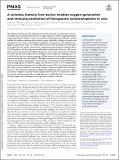A wireless, battery-free device enables oxygen generation and immune protection of therapeutic xenotransplants in vivo
Author(s)
Krishnan, Siddharth R; Liu, Claudia; Bochenek, Matthew A; Bose, Suman; Khatib, Nima; Walters, Ben; O’Keeffe, Laura; Facklam, Amanda; Langer, Robert; Anderson, Daniel G; ... Show more Show less
DownloadPublished version (8.438Mb)
Publisher with Creative Commons License
Publisher with Creative Commons License
Creative Commons Attribution
Terms of use
Metadata
Show full item recordAbstract
The immune isolation of cells within devices has the potential to enable long-term protein replacement and functional cures for a range of diseases, without requiring immune suppressive therapy. However, a lack of vasculature and the formation of fibrotic capsules around cell immune-isolating devices limits oxygen availability, leading to hypoxia and cell death in vivo. This is particularly problematic for pancreatic islet cells that have high O2 requirements. Here, we combine bioelectronics with encapsulated cell therapies to develop the first wireless, battery-free oxygen-generating immune-isolating device (O2-Macrodevice) for the oxygenation and immune isolation of cells in vivo. The system relies on electrochemical water splitting based on a water-vapor reactant feed, sustained by wireless power harvesting based on a flexible resonant inductive coupling circuit. As such, the device does not require pumping, refilling, or ports for recharging and does not generate potentially toxic side products. Through systematic in vitro studies with primary cell lines and cell lines engineered to secrete protein, we demonstrate device performance in preventing hypoxia in ambient oxygen concentrations as low as 0.5%. Importantly, this device has shown the potential to enable subcutaneous (SC) survival of encapsulated islet cells, in vivo in awake, freely moving, immune-competent animals. Islet transplantation in Type I Diabetes represents an important application space, and 1-mo studies in immune-competent animals with SC implants show that the O2-Macrodevice allows for survival and function of islets at high densities (~1,000 islets/cm2) in vivo without immune suppression and induces normoglycemia in diabetic animals.
Date issued
2023-10-03Department
Koch Institute for Integrative Cancer Research at MIT; Massachusetts Institute of Technology. Department of Chemical Engineering; Massachusetts Institute of Technology. Institute for Medical Engineering & ScienceJournal
Proceedings of the National Academy of Sciences
Publisher
Proceedings of the National Academy of Sciences
Citation
Krishnan, Siddharth R, Liu, Claudia, Bochenek, Matthew A, Bose, Suman, Khatib, Nima et al. 2023. "A wireless, battery-free device enables oxygen generation and immune protection of therapeutic xenotransplants in vivo." Proceedings of the National Academy of Sciences, 120 (40).
Version: Final published version